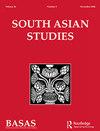Dark Humour and the Female Performance of Subversion in South-Asian Diasporic Cinema: Chadha’s Rich Deceiver, It’s A Wonderful Afterlife, and What Do You Call An Indian Woman Who’s Funny?
IF 0.7
0 ASIAN STUDIES
引用次数: 0
Abstract
This essay focuses on three films from Gurinder Chadha’s South-Asian diasporic oeuvre, Rich Deceiver (1995), It’s A Wonderful Afterlife (2010), and the documentary titled What Do You Call An Indian Woman Who’s Funny? (1994), in order to understand the brand of humour that is theorized and staged from the filmmaker’s diasporic context of hybridity and liminality. I will argue that the female characters in the first two films produce dark humour from a position of marginality – -gendered and class-based in the case of Ellie Freeman (Rich Deceiver), gendered and racialized (diasporic) in the case of Mrs. Sethi (It’s A Wonderful Afterlife) – which in turn allows these characters agency and control in a public space where humour is generally assumed to be the exclusive preserve of masculine authority. I will argue that the very figure of a woman performing/producing dark humour – especially in a racially-inflected diasporic context such as Chadha’s own – functions as a vehicle for the critique of normative social oppression, whether gender-, class-, or race-based, and therefore becomes an inherently empowering template and expository medium both for the female characters and for the genre of South Asian diasporic cinema.南亚散居电影中的黑色幽默与女性颠覆表演:查达的《有钱的骗子》、《美妙的来世》、《你如何称呼一个有趣的印度女人?》
本文聚焦于古林德·查达南亚流散作品中的三部电影:《富有的骗子》(1995)、《美妙的来世》(2010)和纪录片《你如何称呼一个有趣的印度女人?》(1994),以便从电影制作人的混杂性和阈限性的流散背景中理解被理论化和上演的幽默品牌。我认为,前两部电影中的女性角色从边缘地位产生黑色幽默——艾莉·弗里曼(《骗子富翁》)的性别和阶级基础,塞西夫人(《美好的来世》)的性别和种族(散居)——这反过来又让这些角色在公共空间中发挥作用和控制作用,而幽默通常被认为是男性权威的专属。我认为,一个女性表演/制作黑色幽默的形象——尤其是在像查达自己这样的种族影响的流散背景下——作为批判规范性社会压迫的工具,无论是基于性别、阶级还是种族的,因此成为女性角色和南亚流散电影类型的固有授权模板和解释性媒介。
本文章由计算机程序翻译,如有差异,请以英文原文为准。
求助全文
约1分钟内获得全文
求助全文

 求助内容:
求助内容: 应助结果提醒方式:
应助结果提醒方式:


